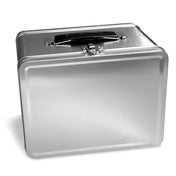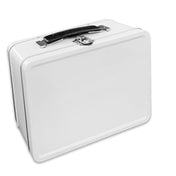Tracing the origins of the all-powerful gems in the Marvel Cinematic Universe reveals just how long Thanos and Marvel have planned the events that will culminate in ‘Avengers: Endgame’
With a simple snap of the fingers, Thanos wiped out half of the planet’s population, including many of Earth’s mightiest heroes. In Avengers: Infinity War, the 19th film of the ever-expanding Marvel Cinematic Universe, the Mad Titan finally (after receiving several makeovers) obtained all six Infinity Stones, which granted him enough power to make such destruction possible. These magical gems can be traced through a number of films dating back to Captain America’s origin in 2011, The First Avenger, as villains like Red Skull, Loki, and Ronan the Accuser have all attempted to wield the Infinity Stones’ unique powers in order to further their own evil agendas.
As Wong and Doctor Strange explain to Tony Stark and Bruce Banner toward the beginning of Infinity War: “The Big Bang sent six elemental crystals hurtling across the virgin universe. These Infinity Stones each control an essential aspect of existence: Space, Reality, Power, Soul, Mind, and Time.”
With the exception of the Soul Stone, every Infinity Stone had appeared in at least one previous movie (the Space Stone has been in at least four) before Infinity War, though they were often embedded in other devices, such as magical objects like the Tesseract, Loki’s Scepter, the Orb, and the Eye of Agamotto. When some of these earlier films were initially released, it wasn’t always clear that these objects contained such ultra-powerful gems, nor was it clear that there was any connection between them. In a vacuum, the Infinity Stones may seem to be no more than simple MacGuffins, plot points that give our heroes something to fight against as we learn the nature of their origin stories. Heading into Infinity War last spring, you didn’t really need to know anything about these colorful rocks or where they came from to be able to enjoy the action blockbuster. But when we look back at all the movies throughout the years, we learn that these stones are also timestamps that show just how far ahead Marvel mapped out its “phases,” with details both big and small interwoven across a vast web of stories and characters.
Fair warning: We’re about to dive deep into the MCU, a universe where tree creatures can say three words and three words only, catlike aliens (that look exactly like cats) can turn into ravenous Demogorgons instantaneously, and people sometimes say stuff like, “You get hurt, hurt ’em back … you get killed, walk it off,” and don’t even crack a smile. It’s going to get weird and nonsensical at times. But there’s something incredible about how Marvel has serialized the movies—much like comic books—with a growing number of converging franchises all contributing to an intricate, if not blemished greater narrative. In tracing the Infinity Stones’ origins as the 22nd MCU film quickly approaches, we can see the roots that lie beneath the surface of a story more than 10 years in the making.
THE INFINITY STONES
The Space Stone
When it first appeared: Captain America: The First Avenger (2011)
The first Infinity Stone we’re introduced to is also the one that appears most frequently: The Space Stone, once contained in a device called the Tesseract, plays a key role in The First Avenger, Captain Marvel, and The Avengers, while making cameos in a few other movies. It even helps provide the model that Tony Stark uses to create a new element in Iron Man 2 (yes, that really happened).
Once obtained by Thanos, the Space Stone is just another tool to help him find the next stone. The Space Stone is capable of opening portals across the galaxy, and it greatly improves Thanos’s commuting time throughout the course of the film (among other things). But before Infinity War, the Space Stone was often one of the more important elements in the MCU films. And it is significant that the first stone we encounter is the one that represents space; it was a big sign that other beings exist in the Marvel universe outside of Earth.
The Space Stone is introduced in one of The First Avenger’s opening scenes, as we see it being recovered from a Norwegian tomb in 1942. Johann Schmidt, a Nazi scientist and the head of a terrorist organization called HYDRA, uses the Stone as a power source to mass-produce advanced weaponry for their army in the war against the Americans. After a deathly skinny Steve Rogers gets injected with the Super-Soldier Serum and becomes the swole Captain America, the future Avenger helps prevent Red Skull—as Schmidt is better known due to that pretty red noggin of his—from leading an attack on the U.S. While Red Skull is fighting Captain America on a plane in one of the final scenes of the movie, he grabs the Tesseract and unwittingly opens up a portal to space that consumes him. Red Skull seemingly vanishes forever (more on that later) and the Tesseract melts through the floor of the plane, dropping down into the Arctic Ocean, not far from where Captain America ends up in a frozen sleep for the next 70 years. Soon after, Howard Stark (father of Tony Stark and a founding member of S.H.I.E.L.D.) retrieves the Tesseract and studies it for years before leaving it with S.H.I.E.L.D.
In Captain Marvel, which is set in 1995, the Tesseract is now the test subject of Project P.E.G.A.S.U.S., an operation led by a U.S. Air Force scientist named Dr. Wendy Lawson, who we later find out is really a Kree scientist named Mar-Vell. She uses the Tesseract to develop an engine that could help save an alien race called the Skrulls, who are on the losing end of an intergalactic war with the Kree.
Carol Danvers is a test pilot helping out Mar-Vell, but she’s completely unaware of her true alien identity (which is unsurprising since Mar-Vell is just Annette Bening with blue blood). When Yon-Rogg, the leader of a Kree military task force, arrives on Earth to steal Mar-Vell’s work for the Kree Empire to use, he kills Mar-Vell before Danvers shoots the engine’s energy core, absorbing its powers in the process. That energy, which was generated from the Tesseract, turns Danvers into Captain Marvel and gifts her with absurdly powerful cosmic abilities that should probably bump Captain America back down to private by association. After sitting in a Flerken’s stomach for a little while—one of those cat aliens I mentioned earlier—the Tesseract ends up back with S.H.I.E.L.D.
Decades later, in Avengers, Loki uses the Tesseract to open up a wormhole that allows for an army of aliens known as the Chitauri to invade New York. After settling all their differences, the newly formed Avengers defeat the Chitauri and close the wormhole to space, and Thor returns to Asgard with an imprisoned Loki and the Tesseract.
The last time we see the Space Stone before Infinity War is when Loki pockets it just before the destruction of Asgard in Thor: Ragnarok. In the opening scene of Infinity War, Thanos kills what seemingly remains of the Asgardian people, except for Thor, and crushes the Tesseract like a pistachio shell to pick out the stone.
The Mind Stone
When it first appeared: Avengers (2012)
In the post-credits scene of Avengers, we learn that Thanos was the one pulling the strings behind Loki’s invasion of New York. He supplied Loki with the alien army and gifted him with the Scepter, a powerful weapon that the trickster god uses to manipulate the minds of Hawkeye, Dr. Erik Selvig, and countless other unsuspecting poor souls. Loki is given the Scepter in the film’s first moments, and he immediately puts it to work when he arrives at S.H.I.E.L.D. headquarters to steal the Tesseract for Thanos. With just a tap in the chest with the Scepter, Loki plays puppet master throughout the movie.
In the next Avengers film, Age of Ultron, we learn that the Mind Stone was the source of the Scepter’s power all along, and it gets used to create several characters: Scarlet Witch, Quicksilver, Vision, and the titular villain, Ultron. After reclaiming Loki’s Scepter from HYDRA in the opening battle scene in Age of Ultron, Tony Stark and Bruce Banner analyze the stone and figure out that its structure works similarly to that of a human brain. Together they unsuccessfully use the stone as a model to create an artificially intelligent peacekeeping program called Ultron, which then turns against its creators and attempts to wipe out humanity. It’s only with the help of Vision, who was created by Ultron and Dr. Helen Cho using the Mind Stone and repurposed by Tony and Bruce with J.A.R.V.I.S.’s interface, that the Avengers are able to defeat Ultron.
In Infinity War, Vision has been alive for years and continues to evolve into more of a human being. He pretty much just turns into Paul Bettany whenever he’s not fighting (with the sweater to match), and he describes the stone as trying to speak with him just before the Children of Thanos land on Earth to find the stones. It’s one of several instances when characters describe the stones as being sentient and reacting to the other stones and what’s happening around them.
The Mind Stone is eventually the last Infinity Stone Thanos needs to complete his genocidal vision of a better universe. The Avengers try to find a way to destroy the Mind Stone while not killing Vision in the process, but they run out of time before Thanos lands for the final battle scene at Wakanda. Thanos rips the stone out of Vision’s forehead, and as Thor’s throw misses the mark on what could’ve been the fatal blow to save humanity (should’ve gone for the head, my guy!), Thanos snaps away half of life’s existence.
The Reality Stone
When it first appeared: Thor: The Dark World (2013)
To be blunt: Dark World is pretty bad. Save yourself the time and just watch the meta-theatrical performance of one of the film’s key events from Thor: Ragnarok (with a little help from Matt Damon).
Five thousand years before the events of Dark World, the ancient race of Dark Elves formed the Reality Stone into the Aether, a weapon that would bring darkness to the nine realms (a bunch of planets across the universe, including Earth).
Malekith, the leader of the Dark Elves, attempted to use the Convergence—an intergalactic event that occurs every 5,000 years when the nine realms align—to spread the darkness. The Asgardians stopped Malekith, nearly wiping out all the Dark Elves in the process, and hid the Aether where they swore no one would ever find it again.
Doctor Jane Foster (Natalie Portman) is brought to the Aether when she accidentally steps through a portal on Earth created by the new Convergence. (Like I said, maybe don’t rewatch this movie.) Unlike the other Infinity gems—or “relics,” as Odin calls them—that often appear as stones, the Aether is “fluid and ever-changing; it changes matter into dark matter.” Malekith and the remaining Dark Elves awaken from a deep slumber that makes Captain America’s 70-year hibernation look like a quick power nap, and they again attempt to use the Convergence as a means of bringing darkness to the nine realms. Malekith eventually reclaims the Aether from Jane Foster, but before he can finish the job he started thousands of years earlier, Thor and Co. defeat the Dark Elves once and for all.
At the end of Dark World, the Asgardians find themselves in possession of two Infinity Stones: the Reality Stone and the Space Stone. But rather than store the Aether in Odin’s vault alongside the Tesseract, they deem it too dangerous to keep two Infinity Stones together in one place. They bring the Aether to the planet Knowhere and leave it in the hands of the Collector, the owner of a vast collection of rare artifacts and species. The stone remains here until Infinity War, when Thanos arrives to add the third gem to his collection.
Although this is indeed the origin story of the Reality Stone in the MCU, the way it appears in Dark World is very different from the way it’s used by Thanos in Infinity War. The Aether is convoluted and is really just a source of power that, as Odin explains, works like a virus that “seeks out host bodies, drawing strength from their life force.” The key takeaway is that it can be used to alter matter and bend the laws of physics and reality.
In Infinity War, the now solidified Reality Stone is no longer a vague power source, and Thanos uses it to create illusions, like when he lures the Guardians of the Galaxy into his trap on Knowhere or when he gives Doctor Strange a history lesson about his home world, or to alter the matter of both people and objects, like when he briefly turns Drax into a pile of rocks.
The Power Stone
When it first appeared: Guardians of the Galaxy (2014)
Although we’re technically introduced to Thanos in Avengers and see him again as he picks up his gauntlet in the mid-credits of Age of Ultron, it’s only when we reach our first Marvel space opera that we start to understand the nature of Thanos’s plan and receive a formal introduction to the skin-bearded purple alien. Following the gut punch of an opening scene when young Peter Quill watches his mother die before being abducted by an alien spaceship, Guardians of the Galaxy kicks off with Star-Lord on an Indiana Jones–style treasure hunt. He’s after an Orb that has long been forgotten and was hidden away for centuries in a secret tomb on the planet Morag. But unlike Indiana Jones, an archaeology professor who seeks out ancient artifacts so they can be preserved and studied, Star-Lord is after the Orb so he can get some cash. He doesn’t even realize what makes the Orb so special.
As we later find out, the Orb contains the Power Stone, the gem that embodies a force destructive enough to wipe out the universe. After Star-Lord, Gamora, Drax, Rocket, and Groot band together to escape from space jail, they attempt to sell the Orb to the Collector on Knowhere. During that visit, the Collector explains the significance and origins of the Infinity Stones, and how the celestial being Eson the Searcher once used the Power Stone to destroy entire planets.
Ronan the Accuser, a radical Kree warrior tasked by Thanos with retrieving the Power Stone, decides to keep the stone for himself once he steals it from the Guardians on Knowhere, and turns his eye toward destroying the planet Xandar. After Ronan is defeated on Xandar through the Guardians’ teamwork, the Five Stairsteps, and some wildly effective hand-holding, the Guardians decide to leave the Power Stone with the Nova Corps, an intergalactic military force headquartered on Xandar. As we learn early on in Infinity War, Xandar is the first stop Thanos makes on his quest for the stones, and the Power Stone is the first piece to completing the Infinity Gauntlet.
The Time Stone
When it first appeared: Doctor Strange (2016)
The Time Stone was protected by the Masters of the Mystic Arts ever since the order was established thousands of years ago by the master sorcerer Agamotto. He created a containment device for it called the Eye of Agamotto, and all the Masters in the years thereafter swore their lives to ensure its safety. The order’s main purpose was to protect Earth from mystical threats, ones that even the Avengers wouldn’t be able to handle in the physical realm—and defending the Eye was high on the priority list.
The stone can be used to reverse past events or fast-forward to see potential futures, like when Doctor Strange looks ahead to all the possible outcomes of their fight against Thanos in Infinity War. Strange first experiments with the Eye of Agamotto by aging and de-aging an apple, and by the end of Doctor Strange he’s mastered it enough to be able to reverse the destruction of Hong Kong and save the planet from the Dark Dimension. Karl Mordo (one of the present-day Masters) at one point warns Strange of the dangers of using the Time Stone: “Temporal manipulations can create branches in time. Unstable dimensional openings. Spacious paradoxes, time loops! You want to get stuck reliving the same moment over and over, forever, or never having existed at all?” And completely unfazed by the prospect, that’s exactly what he does: At the end of the film, Strange traps both himself and the ruler of the Dark Dimension, Dormammu, in a time loop, until he (it?) agrees to leave Earth and take the rogue Master Kaecilius along with him.
In Infinity War, Doctor Strange gives Thanos the Time Stone to save Tony Stark’s life, despite what his oath demanded. And after a heartbreaking moment for Scarlet Witch, when she kills Vision in order to destroy the Mind Stone, Thanos simply uses the Time Stone to bring Vision right back to life, just to rip the stone back out of him and kill him again.
The Soul Stone
When it first appeared: Infinity War (2018)
The sixth and final stone is the only one that didn’t drive the plot of a previous film, and it made its first appearance in Infinity War. For this very reason, it’s also the stone we know the least about. Despite the limited screen time, though, it’s evident from a few key moments that the Soul Stone will be the most important gem to keep in mind heading into Endgame.
In Infinity War, after Gamora reluctantly reveals the Soul Stone’s location to Thanos in order to save her sister Nebula’s life, Thanos takes Gamora to a barren planet called Vormir. Upon their arrival, they’re greeted by Red Skull, who we discover didn’t actually die while fighting Captain America at the end of First Avenger, but rather was cast across the galaxy by the Space Stone when he tried to hold the Tesseract in his hands. All these years later, he’s still ugly as hell—and probably still a Nazi, too—but now his only purpose is to serve as a guide to those who seek the power of the stone. “Soul holds a special place among the Infinity Stones,” Red Skull explains to them. “You might say it has a certain wisdom. … To ensure that whoever possesses it understands its power, the stone demands a sacrifice.” The price that it demands, as we find out moments later, is the life of someone you love; “a soul for a soul.” Thanos tosses Gamora off the edge of a cliff, and in turn, receives the Soul Stone.
As for what it does, this is not as clear as it is with some of the other Infinity Stones. In a Q&A that took place after a special screening back in November, Joe Russo (who with his brother Anthony has directed Captain America: Civil War, Infinity War, Winter Soldier, and Endgame) shed some light on the Soul Stone:
The Soul Stone obviously has the ability to manipulate your soul, the essence of who you are. One key moment where it’s used is where Doctor Strange turns into multiple Stranges and then Thanos uses the Soul Stone to eradicate all the fake Stranges and momentarily shoves Strange out of his own body, and Strange has to pull himself back in. … Of course when Thanos goes to the Soul Stone itself, to speak to his dead daughter, he obviously has an ability to resurrect, conjure the spiritual representation of the people who are dead.
The most revealing part of the quote is in the last line: “an ability to resurrect, conjure the spiritual representation of the people who are dead.” The scene that the Russos are referring to appears after the snap, when creepy young Gamora asks Thanos, “What did it cost?” to which he grimly replies, “Everything.” It’s possible that Gamora, as well as everyone who fades to dust at the end of Infinity War, is still alive and trapped in the “Soul World” where Thanos and his dead daughter speak, but it’s almost certain that this stone will play an important role in bringing back all the Avengers who died in the film’s closing moments. As to what it might cost those still left standing, and which among them may have to be sacrificed … we’ll find out soon enough.
Original article by Daniel Chin appears on The Ringer
Photo by Antikwar1 / Adobe






